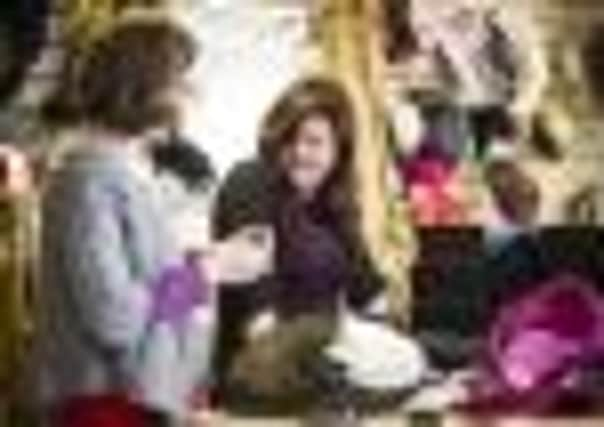Hats by the hundred help Hawick designer to get ahead


Chanel, Louis Vuitton, Harrods and Hermes all source fine cashmere, knitwear and tweed from this quiet Borders town, where traditional ways of manufacturing are still valued.
And now the heart of Hawick has become the home of an internationally-renowned milliner – Yvette Jelfs – who has converted a former tobacconist and sandwich shop into a design studio.
Advertisement
Hide AdAdvertisement
Hide Ad“The great thing about having a business here is that I have got all these raw materials on my doorstep,” says Jelfs.
She shows me a range of soft pastel tweed caps, including her new invention, the “man stalker”, which have been created out of soft pastel tweed woven in Selkirk. Jelfs made the original from an old piece of tweed but despaired of finding the pattern again until she met a man from Selkirk who said: “I think I know what that is.”
The millworker came back with a pile of swatches of vintage tweed originally made for Coco Chanel. These have become the basis of a new range of sewn hats.
She says: “It is a wonderful fabric – it is so warm and it’s pure.” And its a hit. As she leaves her shop for lunch wearing her “man stalker”, the drinkers in the pub opposite hang around on the doorstep and compliment her on her “backwards forwards hat”.
Jelfs, who has formerly had shops in Edinburgh and in London and whose hats have been worn by royalty, supermodels and on the pages of Vogue, says she originally moved to the Borders to “be a housewife” and enjoy country life. But since opening up her design workshop last September she has been rushed off her feet.
Her caps and deerstalkers sell for £150 to £250 while moulded “blocked” hats sell for £250 to £600, but there is no lack of demand. “I am so lucky with my clients. You might think there isn’t anybody who would spend £600 on a hat in Hawick, but there is.
“Stella Tennant’s sister came in and she said: ‘It’s a little piece of Chelsea in the heart of Hawick’.”
As well as keeping up with her couture clients, Jelfs has just won a major contract to supply Jaeger with a designer diffusion range. Liberty and John Lewis are also interested. Demand for quality products made in Scotland is high and Jelfs is now on a mission to source as many raw materials as she can from local suppliers.
Advertisement
Hide AdAdvertisement
Hide AdNature has always been a big inspiration for the designer. She breeds rare pheasants and shows me a light, fluffy circlet hat made of downy feathers. “It is so light, and so warm. Camilla wears hers all the time,” she says.
Hats for ladies’ day at the races are a huge part of the business. Jelfs and designer Jeff Banks set up the organisation Fashion in the Field, which stages fashion shows at the races. But Jelfs says her favourite hat-wearer is Kate Moss “because she mixes things up and throws things together.
“I’m not really into fashion, I’m into style and I’m into elegance. People pay extra to buy something that suits them.
“It’s the people you meet making hats. Hats are a very friendly thing.”
Being at the heart of a Borders mill town has inspired her to think more about the potential for Scottish textiles and Scottish products.
The heart of her business is the blockhouse – filled to the ceiling with hundreds of differently shaped metal moulds which are used for shaping and sculpting hats. “It took me about 20 years to collect all these,” says Jelfs, who began her career in manufacturing in Luton, previously the centre of the millinery industry in the UK. As the hat factories of Luton closed down and were converted into flats Jelfs raided them for their blocks. She has about 700 piled in cupboards and stacked around the walls – some of them vintage shapes used for old-fashioned pillar box hats, trilbies and the oversized cloche known as the Jackie O.
The raw material for making “blocked” hats are hoods – coloured vaguely hat-shaped circles of wool or wool and rabbit fur, or banana fibre or lace which are moulded into shape by being pressed on to a block.
The multicoloured felt hoods Jelfs has piled up in the cupboards in her workshop are mostly imported from Czechoslovakia, but Jelfs would like to persuade the surviving Borders mills to get into felt-making,
Advertisement
Hide AdAdvertisement
Hide Ad“You could take all the waste products from cashmere and blend it with lambs wool to produce a Scottish felt. It could be a really important thing for Scotland.”
Jelfs would also like to source hat boxes and labels from a local supplier. “Ideally I’d like to get everything from within a 20- mile radius of the workshop.”
Although she may have started off by thinking she was going to lead a quiet life in the Borders, her ambitions and her inspiration have grown.
Asked about her aims, it is clear the milliner is dreaming big: “To employ as many people as possible, to get young people back into the industry. And to save the millinery industry as a British product.”
One of her greatest supporters in the Borders has been James Sugden, director of Johnstons of Elgin for 30 years. Johnstons’ mill in Hawick is just across the footbridge and Jelfs and her workers usually pop in for lunch at the visitor centre there.
Sugden says: “This is an extraordinary story. To get a milliner of this calibre in Hawick is extraordinary.”